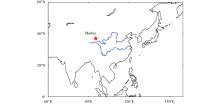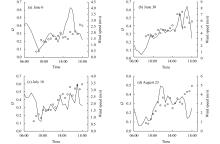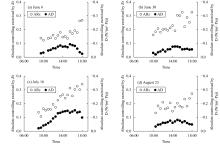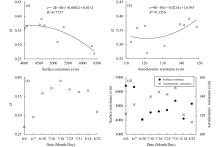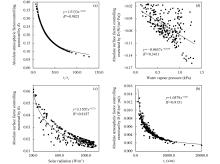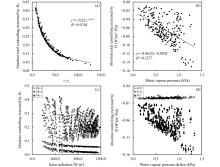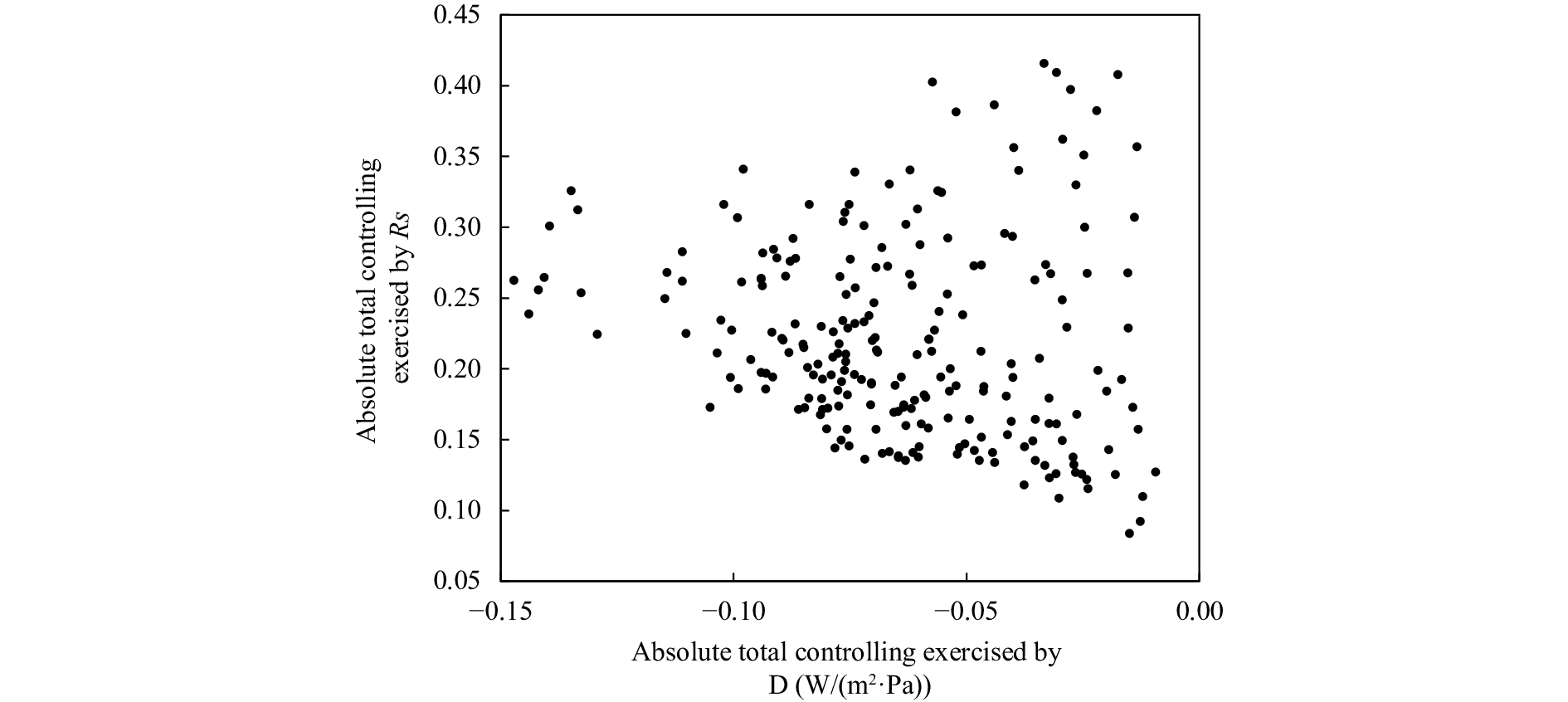Sciences in Cold and Arid Regions ›› 2018, Vol. 10 ›› Issue (4): 305–316.doi: 10.3724/SP.J.1226.2018.00305
Analysis of water vapour flux between alpine wetlands underlying surface and atmosphere in the source region of the Yellow River
Yan Xie1,2,Jun Wen3,*( ),Rong Liu1,Xin Wang1,DongYu Jia1
),Rong Liu1,Xin Wang1,DongYu Jia1
- 1 Key Laboratory of Land Surface Process and Climate Change in Cold and Arid Regions, Northwest Institute of Eco-Environment and Resources, Chinese Academy of Sciences, Lanzhou, Gansu 730000, China
2 University of Chinese Academy of Sciences, Beijing 100049, China
3 College of Atmospheric Sciences, Plateau Atmosphere and Environment Key Laboratory of Sichuan Province, Chengdu University of Information Technology, Chengdu, Sichuan 610225, China
| 1 |
Bao Y, Zuo HC, Lü SH, et al. The effect of improved land surface process parameters in arid area on climatic simulation in GCM. Plateau Meteorology 2004; 23: 2 220- 227.
doi: 10.3321/j.issn:1000-0534.2004.02.014 |
| 2 |
Chen JL, Wen J, Wang X, et al. Characteristics of water and heat exchanges and their crucial influencing factors on the alpine wetland during the warm season in the source region of the Yellow River. Chinese Journal of Atmospheric Sciences 2017; 41: 2 302- 312.
doi: 10.3878/j.issn.1006-9895.1607.16103 |
| 3 |
Chen WM, Gao QX, Hong G Estimating surface radiation budgets over China in summer from GMS satellite data. Scientia Atmospherica Sinica 1997; 21: 2 238- 246.
doi: 10.3878/j.issn.1006-9895.1997.02.13 |
| 4 | Cienciala E, Kučera J, Lindroth A Canopy transpiration from a boreal forest in Sweden during a dry year. Agricultural & Forest Meteorology 1997; 86: 3–4 157- 167. |
| 5 |
Ding RS, Kang SZ, Zhang YQ, et al. Characteristics of water vapor and heat fluxes and the controlling factors over an maize field in the arid inland region. Shuili Xuebao 2014; 45: 3 312- 319.
doi: 10.13243/j.cnki.slxb.2014.03.008 |
| 6 |
Guo JX, Mei XR, Lu ZG, et al. Field evapotranspiration measurement based on eddy covariance technology. Scientia Agricultura Sinica 2004; 37: 8 1172- 1176.
doi: 10.3321/j.issn:0578-1752.2004.08.015 |
| 7 |
He JJ Characteristic of latent heat flux in typical steppe. Chinese Agricultural Science Bulletin 2014; 30: 26 195- 199.
doi: 10.11924/j.issn.1000-6850.2013-3073 |
| 8 |
Held AA, Steduto P, Orgaz F, et al. Bowen ratio/energy balance technique for estimating crop net CO2 assimilation, and comparison with a canopy chamber . Theoretical and Applied Climatology 1990; 42: 4 203- 213.
doi: 10.1007/BF00865980 |
| 9 |
Hu YQ Research advance about the energy budget and transportation of water vapour in the HEIFE area. Advance in Earth Sciences 1994; 9: 4 32- 34.
doi: 10.11867/j.issn.1001-8166.1994.04.0030 |
| 10 |
Jacobs CMJ, De Bruin HAR The sensitivity of regional transpiration to land-surface characteristics: significance of feedback. Journal of Climate 1992; 5: 7 683- 698.
doi: 10.1175/1520-0442(1992)005<0683:TSORTT>2.0.CO;2 |
| 11 |
Jarvis PG, McNaughton KG Stomatal control of transpiration: scaling up from leaf to region. Advances in Ecological Research 1986; 15: 1- 49.
doi: 10.1016/S0065-2504(08)60119-1 |
| 12 |
Kellner E Surface energy fluxes and control of evapotranspiration from a Swedish Sphagnum mire . Agricultural and Forest Meteorology 2001; 110: 2 101- 123.
doi: 10.1016/S0168-1923(01)00283-0 |
| 13 |
Li FX, Chang GG, Xiao JS, et al. Relationship between wetlands changes and climate change in the Yellow River source region. Journal of Natural Resources 2009; 24: 4 683- 690.
doi: 10.11849/zrzyxb.2009.04.014 |
| 14 | Li HM, Li L, Zhang JX, et al. Changes in extreme climatic events over the sources of the three rivers in the prometaphase 21st century. Journal of Glaciology and Geocryology 2012; 34: 6 1403- 1408. |
| 15 |
Li YJ, Xu ZZ, Wang YL, et al. Latent and sensible heat fluxes and energy balance in a maize agroecosystem. Journal of Plant Ecology 2007; 31: 6 1132- 1144.
doi: 10.17521/cjpe.2007.0141 |
| 16 |
Li YJ Environmental controls on water and heat exchanges over rainfed maize cropland in northeast China. Climatic and Environmental Research 2015; 20: 1 71- 79.
doi: 10.3878/j.issn.1006-9585.2014.13181 |
| 17 |
Li YN, Shi SB, Cao GM, et al. The observational studies on characteristics of microclimate in Haibei alpine meadow regions of Qi-Lian Mountain. Plateau Meteorology 2000; 19: 4 512- 519.
doi: 10.3321/j.issn:1000-0534.2000.04.013 |
| 18 |
Mackay DS, Ahl DE, Ewers BE, et al. Physiological tradeoffs in the parameterization of a model of canopy transpiration. Advances in Water Resources 2003; 26: 2 179- 194.
doi: 10.1016/S0309-1708(02)00090-8 |
| 19 |
Mahrt L, Vickers D Boundary-Layer adjustment over small-scale changes of surface heat flux. Boundary-Layer Meteorology 2005; 116: 2 313- 330.
doi: 10.1007/s10546-004-1669-z |
| 20 | Monteith JL, Unsworth M, 1990. Principles of Environmental Physics. 2nd ed. London: Edward Arnold |
| 21 |
Oncley SP, Foken T, Vogt R, et al. The energy balance experiment EBEX-2000. Part I: overview and energy balance. Boundary-Layer Meteorology 2007; 123: 1 1- 28.
doi: 10.1007/s10546-007-9161-1 |
| 22 |
Steduto P, Hsiao TC Maize canopies under twosoil water regimes: Ⅲ. Variation in coupling with the atmosphere and the role of leaf area index. Agricultural and Forest Meteorology 1998; 89: 3–4 201- 213.
doi: 10.1016/S0168-1923(97)00083-X |
| 23 |
Stewart JB Modelling surface conductance of pine forest. Agricultural and Forest Meteorology 1988; 43: 1 19- 35.
doi: 10.1016/0168-1923(88)90003-2 |
| 24 |
Tan P Discuss the importance of wetland protection and reverting cultivated land to wetland. Resources Economization & Environmental Protection 2013; 3 142- 143.
doi: 10.16317/j.cnki.12-1377/x.2014.03.100 |
| 25 |
Trenberth KE, Caron JM, Stepaniak DP The atmospheric energy budget and implications for surface fluxes and ocean heat transports. Climate Dynamics 2001; 17: 4 259- 276.
doi: 10.1007/PL00007927 |
| 26 |
Wang QG, Kellomäki S Role of solar radiation and water vapour pressure deficit in controlling latent heat flux density in a scots pine forest. Boundary-Layer Meteorology 2005; 115: 1 131- 149.
doi: 10.1007/s10546-004-2423-2 |
| 27 |
Wang XX, Liu X, Chen SH, et al. Correlation analysis of water and heat fluxes with environmental variables over lawn in semi-arid area. Journal of Basic Science and Engineering 2008; 16: 5 770- 777.
doi: 10.3969/j.issn.1005-0930.2008.05.018 |
| 28 |
Wever LA, Flanagan LB, Carlson PJ Seasonal and interannual variation in evapotranspiration, energy balance and surface conductance in a northern temperate grassland. Agricultural and Forest Meteorology 2002; 112: 1 31- 49.
doi: 10.1016/S0168-1923(02)00041-2 |
| 29 |
Yu WY, Zhou GS, Chi DC, et al. Evapotranspiration of Phragmites communis community in Panjin wetland and its control factors . Acta Ecologica Sinica 2008; 28: 9 4594- 4601.
doi: 10.1016/S1872-2032(08)60081-5 |
| 30 |
Zhang HH, Zhou BR, Xiao HB Comparison of soil moisture and heat features between alpine meadow and alpine wetland. Journal of Arid Meteorology 2015; 33: 5 783- 789.
doi: 10.11755/j.issn.1006-7639(2015)-05-0783 |
| 31 |
Zhang Q, Cao XY The influence of synoptic conditions on the averaged surface heat and radiation budget energy over desert or Gobi. Chinese Journal of Atmospheric Sciences 2003; 27: 2 245- 254.
doi: 10.3878/j.issn.1006-9895.2003.02.11 |
| 32 |
Zhu CM, Lettenmaier DP Long-term climate and derived surface hydrology and energy flux data for Mexico: 1925-2004. Journal of Climate 2007; 20: 9 1936- 1946.
doi: 10.1175/JCLI4086.1 |
| No related articles found! |

